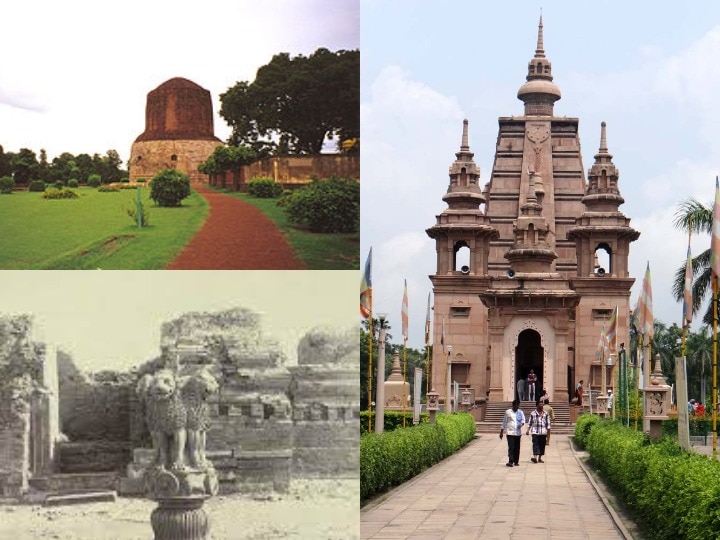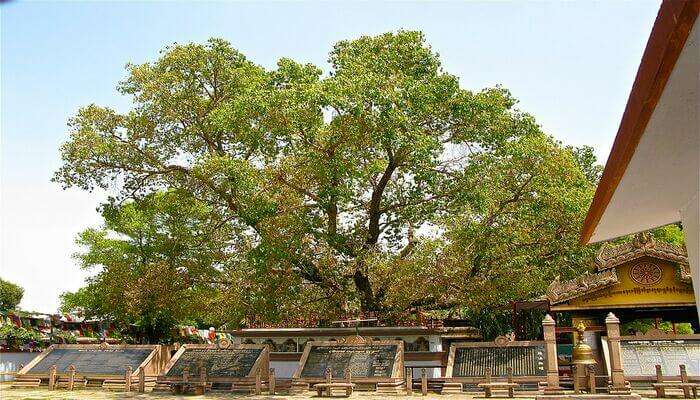About Sarnath Temple

Sarnath Temple, located in Varanasi, Uttar Pradesh, is an iconic and historically significant Buddhist site in India. It is renowned as the place where Lord Buddha delivered his first sermon, known as the "Dhammacakkappavattana Sutta" or the "Wheel of Dharma," to his first five disciples, setting in motion the spread of his teachings.
Also called Isipatana, Sarnath is not just a temple but a complex that encompasses a variety of Buddhist structures, stupas, monasteries, and archaeological remnants that offer a glimpse into the ancient Buddhist civilization. The Dhamek Stupa in Sarnath, with its striking cylindrical shape and intricate carvings, is one of the key attractions. It is believed to mark the exact spot where Buddha gave his first sermon.
Sarnath Temple holds immense spiritual and historical significance for Buddhists worldwide. It is a place of pilgrimage and reflection, drawing devotees and tourists alike to its serene and spiritually charged atmosphere. The site's rich heritage and archaeological treasures also make it a UNESCO World Heritage Site, preserving its importance for generations to come.
Visitors to Sarnath Temple not only have the opportunity to explore its religious heritage but also to appreciate the peaceful ambiance, exquisite sculptures, and the teachings of Buddha that continue to inspire seekers of enlightenment. It is a place where the teachings of compassion, non-violence, and the path to enlightenment are not just a part of history but remain very much alive in the hearts of those who visit.
Why is the Sarnath temple famous?
Sarnath Temple is famous for several reasons:
First Sermon of Buddha: Sarnath is renowned as the place where Lord Buddha, also known as Siddhartha Gautama, delivered his first sermon after attaining enlightenment. This sermon, known as the "Dhammacakkappavattana Sutta" or the "Wheel of Dharma," marked the beginning of his teaching mission and is a fundamental event in Buddhist history.
Historical Significance: It holds immense historical importance as one of the four main pilgrimage sites for Buddhists, the others being Lumbini (Buddha's birthplace), Bodh Gaya (where he attained enlightenment), and Kushinagar (where he achieved Parinirvana).
Dhamek Stupa: Sarnath is home to the Dhamek Stupa, an impressive cylindrical structure with intricate carvings. It is believed to mark the exact spot where Lord Buddha delivered his first sermon. The stupa is a significant symbol of Buddhism and a major attraction for visitors.
Archaeological Treasures: The Sarnath archaeological site is a treasure trove of ancient Buddhist artifacts and structures, including monasteries, sculptures, and inscriptions that provide insights into the rich Buddhist heritage of the region.
World Heritage Site: Sarnath Temple and its surroundings have been recognized as a UNESCO World Heritage Site, ensuring its preservation and acknowledgment as a site of global cultural and historical importance.
Spiritual Pilgrimage: Sarnath continues to attract Buddhists and spiritual seekers from all over the world who come to pay their respects, meditate, and reflect on the teachings of Lord Buddha in the tranquil and spiritually charged ambiance.
Cultural Significance: The site's historical and cultural significance extends beyond Buddhism, as it reflects India's ancient heritage and its role in the development and dissemination of one of the world's major religions.
In summary, Sarnath Temple is famous primarily for its association with the first sermon of Lord Buddha and its role as a pivotal site in the history of Buddhism, attracting visitors and scholars interested in both its spiritual and historical significance.
What is the famous thing of Sarnath?

The stupa is a massive cylindrical structure adorned with intricate carvings and designs. It is a visual representation of the rich Buddhist heritage of the region and holds great historical and spiritual significance. Pilgrims and tourists from around the world visit Sarnath primarily to pay their respects at the Dhamek Stupa, meditate, and reflect on the teachings of Lord Buddha in the tranquil and spiritually charged atmosphere of this sacred site.
Who made Sarnath Temple?
The Sarnath Temple complex, which includes the Dhamek Stupa and other structures, was not built by a single individual but evolved over centuries. The initial construction and development of Sarnath as a significant Buddhist site can be attributed to various Buddhist kings, emperors, and monastic communities.
The Dhamek Stupa, in particular, is believed to have been constructed during the reign of Emperor Ashoka in the 3rd century BCE. Ashoka, a powerful Mauryan emperor, played a pivotal role in spreading Buddhism and is known for building numerous Buddhist stupas, pillars, and monasteries across India.
However, Sarnath's historical and architectural evolution continued over the years, with contributions from subsequent rulers, patrons, and Buddhist communities. The site has been restored and expanded upon by various dynasties and religious followers, each leaving their mark on this sacred place.
Who built Sarnath temple and when?

Sarnath doesn't have a single specific "temple" like many other famous religious sites but rather a complex of Buddhist monuments. The most iconic structure in Sarnath is the Dhamek Stupa. The Dhamek Stupa is believed to have been originally constructed during the reign of Emperor Ashoka in the 3rd century BCE. Emperor Ashoka, a significant patron of Buddhism, built numerous stupas and monasteries, including the Dhamek Stupa, to commemorate and spread the teachings of Buddhism.
The Dhamek Stupa, with its impressive cylindrical shape and intricate carvings, is thought to mark the spot where Lord Buddha delivered his first sermon after attaining enlightenment. Over the centuries, it has been restored and expanded upon by various rulers and Buddhist communities.
So, the construction of the Dhamek Stupa in Sarnath dates back to the 3rd century BCE during the reign of Emperor Ashoka, making it one of the oldest and most historically significant Buddhist monuments in India.
What is the full name of Sarnath?
The full name of the place is simply "Sarnath." Sarnath is an important historical and religious site in India, and it is not typically associated with a longer or more complex name. It is commonly referred to as Sarnath, and this name is used to describe the location and the various Buddhist monuments and structures found there.
The Famous Tree in Sarnath

The famous tree associated with Sarnath is the Bodhi Tree. While Sarnath is primarily renowned for its association with the first sermon of Lord Buddha and the Dhamek Stupa, the Bodhi Tree holds immense significance in Buddhism.
The Bodhi Tree is the type of tree under which it is believed that Siddhartha Gautama, who later became the Buddha, attained enlightenment in Bodh Gaya, a different location in India. While Sarnath does not have the original Bodhi Tree, it is recognized as one of the four holy sites associated with Lord Buddha's life and teachings.
The significance of the Bodhi Tree in Sarnath lies in the fact that it represents the broader pilgrimage circuit connected to the life and teachings of Buddha in India.
Why is Sarnath called as lion capital?
Sarnath is often associated with the "Lion Capital," which is a prominent emblem of ancient India and an important symbol in Buddhist art. The "Lion Capital of Ashoka" is not located in Sarnath itself but was originally erected at Sarnath by Emperor Ashoka.
This lion capital is famous for its four beautifully carved lions seated back to back, symbolizing the four directions, and is mounted on top of an Ashoka Pillar. The capital was originally erected in Sarnath to mark the place where Lord Buddha is believed to have delivered his first sermon. The capital features an Ashoka Chakra (wheel) below the lions and is considered one of the finest examples of Mauryan sculpture.
The significance of the Lion Capital lies in its representation of Ashoka's embrace of Buddhism and his commitment to spreading the teachings of Buddha. It is also a symbol of the Mauryan Empire and an emblem of the modern Indian Republic. The Lion Capital, featuring the four lions and the Ashoka Chakra, is now the national emblem of India and is prominently featured on the Indian national flag.
So, Sarnath is associated with the Lion Capital due to its historical connection to Emperor Ashoka, who erected this emblem in Sarnath to commemorate Lord Buddha's teachings and spread the message of Buddhism.
What is the unique feature of the Lion Capital associated with Sarnath, and why is it important?
The unique feature of the Lion Capital associated with Sarnath is its exceptional artistic and symbolic value. The Lion Capital is an emblem that consists of four exquisitely carved lions seated back to back, mounted atop an Ashoka Pillar. This emblem also features an Ashoka Chakra (wheel) below the lions. The Lion Capital is made of polished sandstone and is known for its remarkable craftsmanship.
The importance of the Lion Capital lies in several key aspects:
Symbol of Ancient India: The Lion Capital is an iconic symbol of ancient India and the Mauryan Empire, dating back to the 3rd century BCE. It represents a historical era when Emperor Ashoka ruled much of the Indian subcontinent.
Connection to Buddhism: The four lions on the capital represent the Four Noble Truths and the Buddhist concept of the "Wheel of Dharma." The Lion Capital's placement at Sarnath marks the site where Lord Buddha gave his first sermon, making it an important Buddhist symbol.
Indian National Emblem: The Lion Capital is now the national emblem of India, featured prominently on official documents, government seals, and the Indian national flag. It was adopted as the national emblem on January 26, 1950, when India became a republic.
Worldwide Recognition: The Lion Capital, along with the Ashoka Chakra, is recognized worldwide as a symbol of India's rich heritage, its association with Buddhism, and its commitment to principles such as non-violence and the spread of dharma.
In summary, the Lion Capital associated with Sarnath is important due to its historical, artistic, and symbolic significance. It represents a pivotal period in Indian history, its connection to Buddhism, and its role as the national emblem of India, making it a symbol of pride and heritage for the nation.
Conclusion:
In conclusion, Sarnath Temple stands as a sacred and historically significant site that holds a profound place in the history and dissemination of Buddhism. It is here that Lord Buddha delivered his first sermon, setting in motion the spread of his teachings and the establishment of the Buddhist monastic community. The Dhamek Stupa, the Bodhi Tree, and the Lion Capital associated with Sarnath serve as enduring symbols of the rich heritage of Buddhism and the Mauryan Empire.
Sarnath's importance extends beyond religious boundaries. Its archaeological treasures provide a window into the ancient Buddhist civilization, and its recognition as a UNESCO World Heritage Site ensures its preservation for future generations. The site continues to be a pilgrimage destination, attracting Buddhists and tourists from around the world, who come to pay homage, meditate, and reflect on the profound teachings of Lord Buddha.
Sarnath Temple remains a testament to the enduring legacy of Buddhism and its role in shaping the cultural and spiritual landscape of India. Its significance continues to shine as a beacon of peace, enlightenment, and historical preservation.


